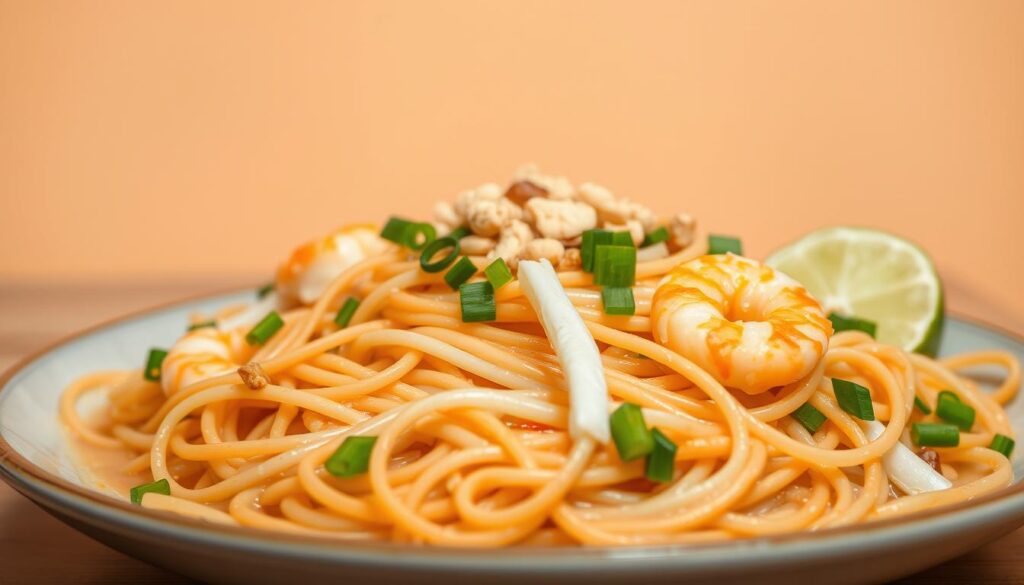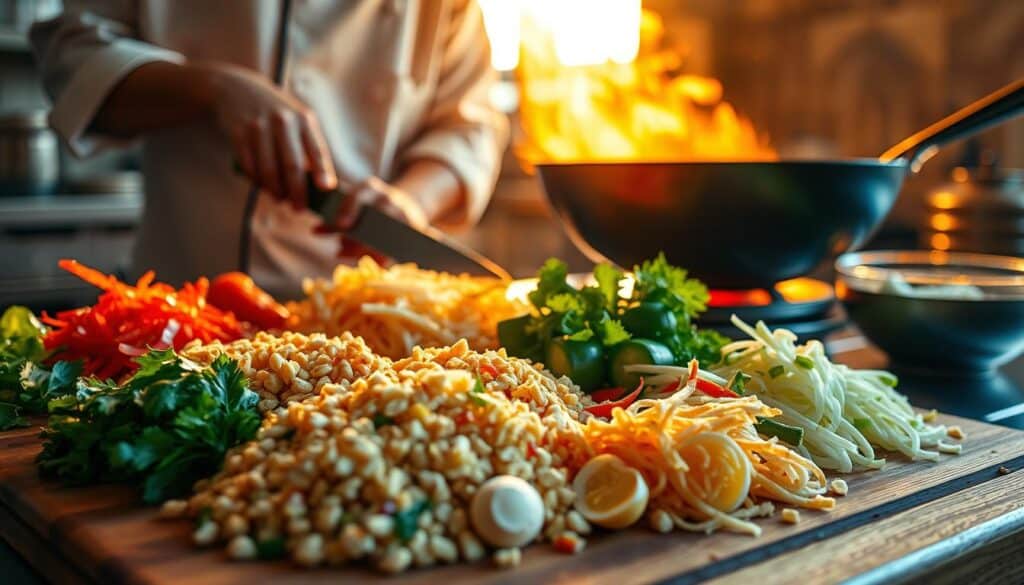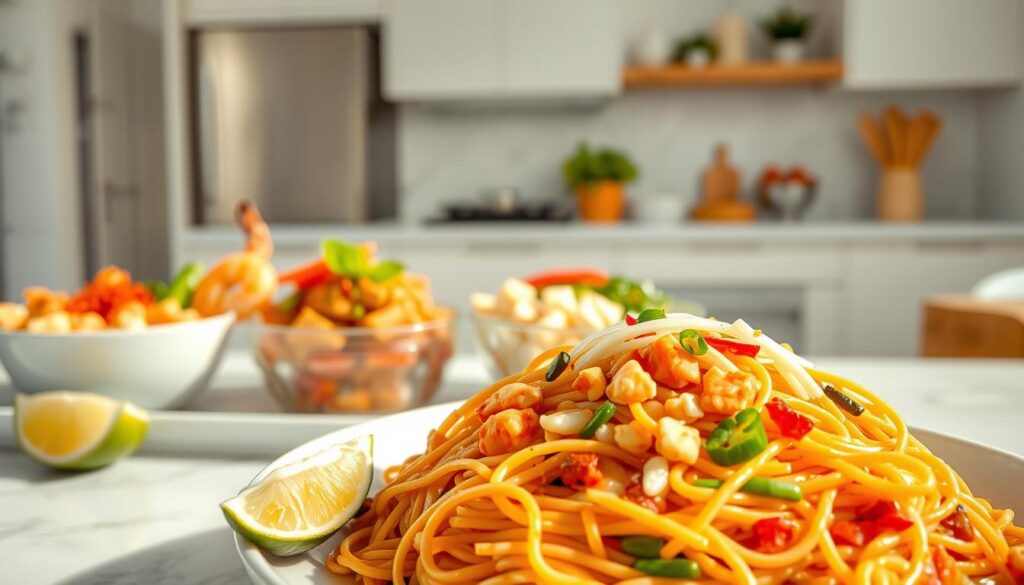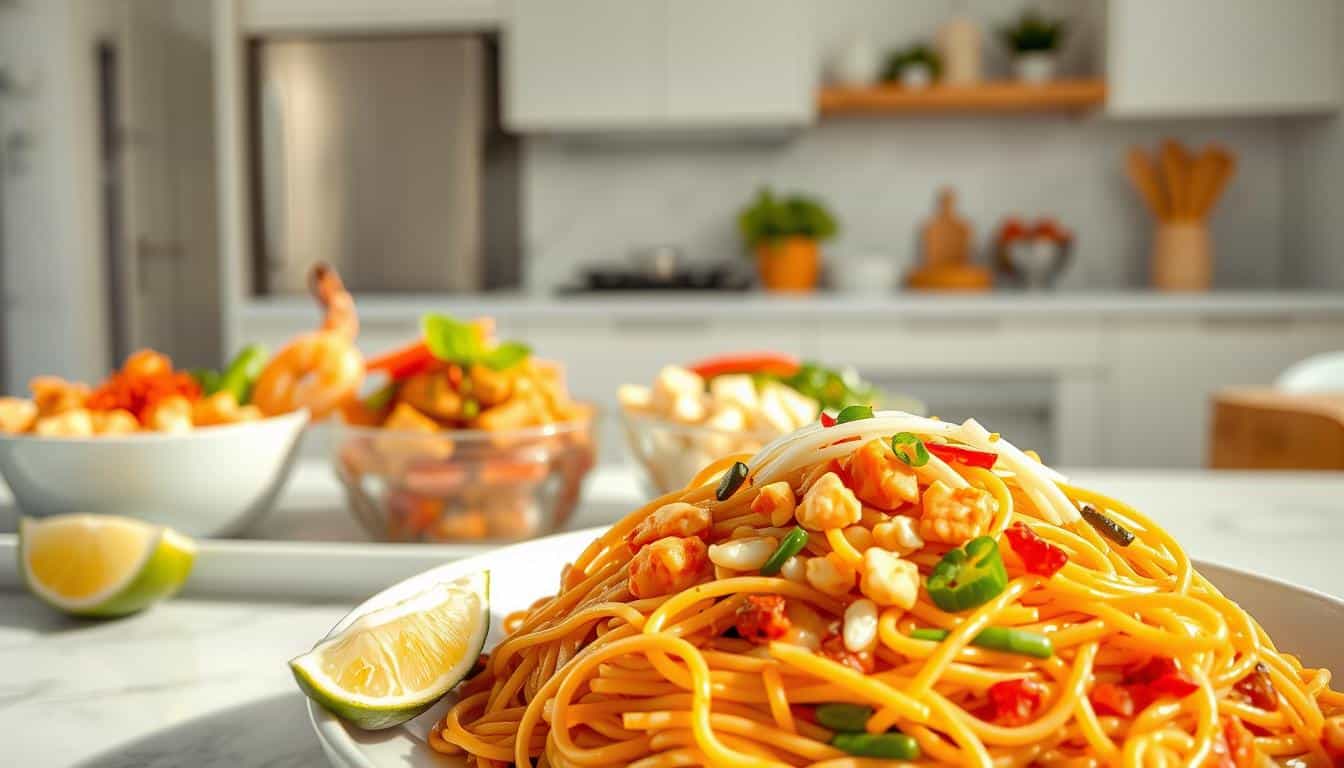There’s something special about a dish that can transport you to another place with just one bite. For me, that dish is Authentic Pad Thai. I still remember the first time I tasted it—the perfect balance of sweet, salty, and sour flavors, the crunch of peanuts, and the freshness of lime. It was love at first bite!
Thank you for reading this post, don't forget to subscribe!Over the years, I’ve perfected my version of this iconic Thai dish. It’s all about the harmony of flavors and textures: tender rice noodles, scrambled eggs, crisp veggies, and a sprinkle of peanuts. The homemade Pad Thai sauce is the heart of the recipe, made with fresh ingredients like tamarind, fish sauce, and palm sugar. And the best part? It’s ready in under 30 minutes!
This recipe is more than just a meal; it’s a reflection of my passion for authentic, handmade food. Inspired by family recipes and local Thai restaurants, I’ve crafted a dish that’s both quick and flavorful. Whether you’re a busy professional or a home cook looking for a new challenge, this Pad Thai is designed to bring a taste of Thailand right to your kitchen table.
Ready to get started? Let’s dive into the details of this iconic dish and explore the tips and tricks that make it truly unforgettable. And if you’re looking for another quick and delicious meal, check out my recipe for chicken in tomato sauce—it’s a crowd-pleaser!

Key Takeaways
- Pad Thai combines rice noodles, eggs, veggies, and peanuts for a balanced texture.
- The homemade sauce is made with tamarind, fish sauce, and palm sugar for authentic flavor.
- The dish can be prepared in under 30 minutes for a quick meal.
- Inspired by family recipes and local Thai restaurants for an authentic taste.
- Perfect for both busy professionals and home cooks looking for a new challenge.
Introduction to My Favorite Pad Thai
Pad Thai holds a special place in my heart, reminiscent of my mom’s cooking. It’s a dish that perfectly balances sweet, sour, and salty flavors, creating a harmonious taste experience. This recipe stands out for its authentic homemade sauce made with fresh ingredients like tamarind and fish sauce, and it’s ready in just 30 minutes.
Why I Love Pad Thai
I love Pad Thai because it’s quick, easy, and bursting with flavor. It’s perfect for busy weeknights and can be customized with your favorite protein or veggies. The recipe includes tips to achieve the best taste, making it a must-try for home cooks.
An Overview of This Recipe Post
This post shares my personal connection with Pad Thai, its easy preparation, and the key components like rice noodles, eggs, and peanuts. I’ll guide you through the process with insider secrets and set you up for success with detailed steps coming up next.
The Rich History of Pad Thai
Pad Thai, a dish beloved worldwide, has a fascinating history that reflects Thailand’s cultural journey. Created in the 1930s, it was part of a national identity campaign during Thailand’s nation-building efforts. The government promoted it to reduce rice consumption during WWII, making it a staple in Thai cuisine.
Origins and Cultural Significance
Pad Thai was introduced by Prime Minister Plaek Phibunsongkhram to unify the country under a single national identity. It combined Chinese-influenced stir-fried noodles with local flavors, creating a harmonious balance of sweet, sour, and salty tastes. The dish quickly became a symbol of Thai unity and is now the national dish.
Evolution in American Kitchens
In the U.S., Pad Thai gained popularity as Thai restaurants multiplied. The Thai government’s initiative to globalize the cuisine led to nearly tripling Thai restaurants worldwide. American chefs adapted the recipe, substituting ingredients like tofu for shrimp, catering to local tastes while retaining its authentic essence.
| Aspect | Thailand | America |
|---|---|---|
| Ingredients | Traditionally uses shrimp, fish sauce, and tamarind. | Often substitutes tofu for shrimp and simplifies sauce ingredients. |
| Cooking Method | Street vendors stir-fry in woks over high heat. | Restaurants may use adapted techniques and pre-made sauces. |
| Cultural Impact | Symbol of national unity and pride. | Popularized Thai cuisine, appearing in every major U.S. city. |
Essential Ingredients Overview
When it comes to crafting an authentic Pad Thai, the right ingredients make all the difference. This dish is a beautiful blend of proteins, fresh vegetables, and aromatic toppings that create a harmonious balance of flavors and textures.
Key Proteins and Vegetables
Your protein options are versatile—choose from chicken, shrimp, or tofu for a vegetarian twist. Each adds a unique flavor and texture. Pair these with crisp vegetables like bean sprouts and carrots for freshness and bite.
Must-Have Noodles and Toppings
Rice noodles are the foundation, providing the perfect chew. Top with roasted peanuts for crunch and a squeeze of lime for tang. Fresh herbs like green onions and cilantro add brightness, while chili flakes can add heat for those who like it spicy.
Remember, authentic ingredients are key to capturing the true essence of this beloved dish.
- Chicken, shrimp, or tofu for protein
- Bean sprouts and carrots for crunch
- Rice noodles for authentic texture
- Peanuts and lime wedges for topping
Preparing Your Ingredients Like a Pro
Preparation is the backbone of any successful dish. When it comes to creating an authentic and delicious meal, having all your ingredients ready can make all the difference. This section will guide you through the essential steps of chopping, measuring, and organizing your ingredients like a professional chef.
Chopping and Measuring Essentials
To ensure your cooking process is smooth and efficient, start by prepping your ingredients. Begin with your protein of choice—chicken, shrimp, or tofu—and slice it into thin strips. For vegetables, finely chop the onion and green onion, ensuring they are uniform in size for even cooking.
Next, measure your ingredients accurately. Use a tablespoon to measure oils and sauces, and ensure your spices are precisely portioned. This attention to detail will help maintain the dish’s balance of flavors. Remember, accurate measurement is key to achieving the perfect taste.
Organize your prepped ingredients in separate bowls. This mise en place technique keeps your workspace tidy and allows you to add each component seamlessly during cooking. It’s a simple step that makes a big difference in the overall process.
| Ingredient | Preparation Steps |
|---|---|
| Protein | Slice into thin strips for quick cooking. |
| Onion | Finely chop for even distribution of flavor. |
| Green Onion | Thinly slice for a fresh garnish. |
| Sauce Components | Measure using a tablespoon for precision. |
A personal tip I’ve learned is to separate ingredients into individual bowls before starting. This not only keeps things organized but also prevents any last-minute scrambling. By taking the time to properly prepare and measure your ingredients, you set yourself up for a stress-free and enjoyable cooking experience.

Creating the Perfect Pad Thai Sauce
The heart of a great Pad Thai lies in its sauce. It’s a delicate balance of sweet, sour, and salty flavors that bring the entire dish together. I love how the sauce can be tailored to personal taste, making each batch unique.
Balancing Sweet, Sour, and Salty
The sauce is a harmonious mix of fish sauce for saltiness, sugar or palm sugar for sweetness, and tamarind paste or vinegar for that tangy sour note. To make the sauce, simply whisk these ingredients together in a bowl until smooth. If you prefer a creamier texture, adding a tablespoon of peanut butter can elevate the sauce to the next level.
Tips on Substitutions and Variations
Not all ingredients are easy to find, so substitutions can be helpful. For instance, if tamarind paste isn’t available, a mixture of equal parts lime juice and brown sugar makes a great substitute. Palm sugar can be replaced with honey or maple syrup for a similar sweet flavor. Feel free to adjust the amounts of each component to suit your taste preferences.
| Ingredient | Traditional | Modern Substitution |
|---|---|---|
| Fish Sauce | Essential for authentic flavor | Use soy sauce as a substitute |
| Sweet Component | Palm sugar or sugar | Honey or maple syrup |
| Sour Component | Tamarind paste or vinegar | Lime juice mixed with brown sugar |
Remember, the key to a perfect sauce is tasting as you go. Adjust the sweetness, sourness, or saltiness by adding a little more of any ingredient until the flavors feel just right to you.
Step-by-Step Cooking Instructions
Cooking an authentic dish like Pad Thai requires attention to detail and a bit of practice, but with these clear steps, you’ll master it in no time. Let’s break it down into simple, manageable parts.
Cooking the Rice Noodles
Start by cooking your rice noodles according to the package instructions. Typically, they need a 5-10 minute soak in hot water until just tender. Once done, rinse them under cold water to stop cooking and set aside. This ensures they stay separate and don’t become sticky.
Sautéing Protein and Veggies
Heat a tablespoon of oil in a large pan over medium-high heat. Add your choice of protein—chicken or shrimp—and cook until lightly browned. Remove and set aside. In the same pan, add another tablespoon of oil and quickly stir-fry your veggies, like bean sprouts and carrots, until crisp-tender. This step should take about 2-3 minutes to preserve texture and color.
Scrambling Eggs to Perfection
Push the veggies to one side of the pan and crack in the eggs. Let them sit for a moment, then gently scramble them. Once cooked, mix them with the veggies. This method ensures the eggs are fluffy and well incorporated into the dish.
Remember to taste as you go and adjust the seasoning to balance the flavors. The key is to stir-fry quickly to maintain the vibrant colors and textures of the ingredients. Combine everything with the sauce and toss until well coated. Your Pad Thai is now ready to be enjoyed!
Optimizing Your Cooking Time and Techniques
Cooking a delicious meal doesn’t always mean spending hours in the kitchen. With the right strategies, you can create a flavorful dish in just 30 minutes. Let’s explore how to optimize your time and techniques for the best results.
Managing a 30-Minute Meal
Maintaining proper heat and timing is crucial for a quick yet tasty meal. Start by prepping your ingredients ahead of time to save minutes during cooking. Use a cup to measure out your ingredients precisely, ensuring everything is ready when you need it.
Here are some time-saving tips:
- Simultaneously cook your noodles and prep your veggies to save time.
- Use a tablespoon of oil for sautéing to prevent sticking without extra cleanup.
- Stir-fry your protein and veggies quickly over high heat to maintain crispiness.
- Add your pre-made Thai sauce towards the end to coat everything evenly.
For a perfect balance, mastering stir-frying techniques can make a big difference. Remember, the key is to keep things moving in the pan to avoid overcooking. With these tips, you’ll be enjoying your meal in no time!
Variations to Customize Your Pad Thai
Pad Thai is a dish that thrives on creativity and adaptability. Whether you’re catering to dietary restrictions or personal preferences, there are plenty of ways to make this recipe your own. Let’s explore some exciting variations that keep the dish fresh and flavorful while respecting its core identity.
Vegan and Vegetarian Adaptations
For a vegan version, simply omit the egg and substitute tofu for the protein. This not only makes the dish plant-based but also retains its hearty texture. Vegetarian options can include chicken or shrimp, but tofu is a fantastic alternative that absorbs the sauce beautifully. Bean sprouts add a delightful freshness, making them a perfect addition for veggy lovers.
Gluten-Free Tips and More
Going gluten-free is easy with Pad Thai. Swap traditional soy sauce for tamari to maintain that savory depth. You can also adjust the spice level by managing the amount of pepper and chili paste. These tweaks ensure the dish remains authentic in flavor while accommodating different dietary needs.
| Variation | Substitution | Benefit |
|---|---|---|
| Protein | Tofu instead of chicken or shrimp | Vegetarian and vegan-friendly |
| Sauce | Tamari instead of soy sauce | Gluten-free option |
| Spice | Adjust pepper and chili paste | Customizable heat level |
These variations show how versatile Pad Thai can be. Whether you’re vegan, vegetarian, or gluten-free, you can enjoy this dish without compromising on flavor. Feel free to experiment and make it your own!

My Personal Pad Thai Experience and Tips
Over the years, I’ve fallen deeply in love with Pad Thai, a dish that’s become a staple in my kitchen. It’s more than just a meal; it’s a journey of flavors and memories that never fails to delight. In this section, I’ll share my personal journey with this iconic recipe and the insider tips that have helped me perfect it.
Stories from My Kitchen
I remember the first time I made Pad Thai at home. It was a bit of a disaster! The noodles stuck together, the sauce was too sweet, and the eggs were overcooked. But I didn’t give up. I kept experimenting, tweaking the recipe here and there, until it finally felt just right. Now, it’s a dish I make with confidence and love.
Insider Secrets for Extra Flavor
One of my favorite tricks is to add a tablespoon of peanut butter to the sauce. It gives the dish a creamy, rich flavor that elevates it to the next level. I also like to use fresh garlic, which I mince finely and sauté in a little oil before adding the other ingredients. This step adds a depth of flavor that’s hard to replicate with pre-minced garlic.
Another tip I’ve learned is to use the right oil for stir-frying. I prefer using a neutral oil with a high smoke point, like canola oil, to ensure the dish doesn’t become greasy or overpowering. A little oil goes a long way in achieving that perfect stir-fry texture.
| Tips for Success | Technique |
|---|---|
| Garlic | Mince finely and sauté in oil for added depth of flavor. |
| Oil | Use a neutral oil like canola for a clean, non-greasy taste. |
| Sauce | Add a tablespoon of peanut butter for a creamy texture. |
Remember, the key to a great Pad Thai is balance—sweet, sour, salty, and umami all working together in harmony. Don’t be afraid to taste as you go and adjust the flavors to your liking. With a little practice and patience, you’ll be making Pad Thai like a pro!
Troubleshooting Common Pad Thai Challenges
Cooking Pad Thai can sometimes present unexpected challenges, but with the right tips, you can overcome them effortlessly. Whether it’s sticky noodles or unbalanced flavors, I’ve got you covered with practical solutions to ensure your dish turns out perfectly every time.
Dealing with Sticky Noodles
One of the most common issues when preparing Pad Thai is sticky noodles. To avoid this, always rinse your noodles under cold water after cooking and set them aside. This step stops the cooking process and prevents the noodles from becoming overly soft or clumpy. If you notice the noodles sticking together in the pan, gently stir them with a little water to loosen them up without adding too much extra moisture.
Adjusting Flavors on the Fly
Flavor balance is crucial in Pad Thai. If the dish tastes too salty, a splash of fresh lime juice can help neutralize it. Conversely, if it’s too bland, a tablespoon of fish sauce or a sprinkle of pepper can enhance the flavor. Remember, small adjustments make a big difference, so taste as you go and tweak the seasoning accordingly.
- Monitor water levels to maintain the perfect noodle texture.
- Stir constantly in the pan to prevent sticking and ensure even cooking.
- Adjust seasoning with fish sauce or lime juice for balance.
Don’t let minor setbacks discourage you. With practice, you’ll master the techniques and enjoy a delicious, authentic Pad Thai every time!
Pad Thai: Rice noodles stir-fried with eggs, vegetables, and peanuts.
Pad Thai is more than just a dish; it’s a celebration of flavors and textures. At its core, it’s a harmonious blend of rice noodles, eggs, crisp vegetables, and peanuts, all brought together by a savory sauce. This combination is what makes Pad Thai so beloved—it’s a dish that’s both familiar and exciting, comforting yet adventurous.
The magic lies in its balance. Rice noodles provide a soft, chewy base, while eggs add creaminess. Vegetables like bean sprouts and carrots bring freshness and crunch, and peanuts offer a satisfying texture. The sauce, made with fish sauce, garlic, and a touch of sweetness, ties everything together. Each bite is a perfect mix of sweet, sour, salty, and umami flavors.
This dish is deeply rooted in tradition but adaptable to modern tastes. Whether you’re using shrimp, chicken, or tofu, the core elements remain the same. Fresh ingredients are key, and the simplicity of the recipe allows each component to shine. Understanding these fundamentals makes cooking Pad Thai a joyful experience, ensuring every plate is a delight.
Conclusion
Creating an authentic Pad Thai is a journey that combines tradition with personal touches. By following this recipe, you’ve learned how to craft a dish that’s both flavorful and visually appealing. Remember, the key to a memorable meal lies in the balance of your sauce, the texture of your noodles, and the freshness of your garnishes.
Your efforts in the kitchen are about more than just cooking—they’re about sharing love and creating memories. I hope this recipe has inspired you to experiment and make Pad Thai your own. Don’t forget to garnish with a squeeze of lime and a sprinkle of peanuts for that perfect finish.
I’d love to hear about your experience! Share your thoughts in the comments below and let me know how your dish turned out. If you enjoyed this recipe, give it a try and share your version on social media. Your feedback helps me improve and brings our cooking community closer together.
Thank you for being part of this culinary adventure. Happy cooking, and I look forward to hearing your stories in the comments!
FAQ
What makes Pad Thai sauce authentic?
Authentic Pad Thai sauce is made with a balance of sweet, sour, and salty flavors. It typically includes ingredients like fish sauce, soy sauce, sugar, and lime juice. Some recipes also add a touch of vinegar or tamarind paste for extra depth.
Can I make Pad Thai vegetarian?
Absolutely! You can easily make a vegetarian version by substituting the protein with tofu or adding extra bean sprouts. Simply omit the fish sauce and use a vegetarian alternative like soy sauce or tamari to maintain the umami flavor.
How long does it take to cook Pad Thai?
Pad Thai is a quick dish to prepare. Once your ingredients are ready, the cooking process takes about 10-15 minutes. This includes cooking the rice noodles, stir-frying the protein and veggies, and combining everything in the pan.
What’s the best way to prevent noodles from sticking?
To keep your rice noodles from sticking, rinse them thoroughly after soaking and stir-fry them quickly in a hot pan with a little oil. Make sure the pan is well-heated before adding the noodles.
Can I adjust the flavor of the sauce to my taste?
Yes! Taste the sauce as you go and adjust it by adding more lime juice for acidity, sugar for sweetness, or fish sauce for saltiness. You can also add a pinch of pepper for extra depth.
What are some common substitutions for shrimp?
If you don’t have shrimp, you can use chicken, tofu, or even vegetables like green onion and bean sprouts as substitutes. The key is to maintain a good protein-to-vegetable ratio for a balanced dish.
How do I ensure the eggs are cooked perfectly?
Push the noodles and veggies aside in the pan, then scramble the eggs in the empty space. Once they’re almost cooked, mix everything together. This keeps the eggs fluffy and well-integrated into the dish.
Can I make Pad Thai gluten-free?
Yes! Use gluten-free soy sauce or tamari and ensure your fish sauce is gluten-free. Be mindful of any added ingredients in store-bought sauces to avoid gluten.
What’s the secret to achieving the right flavor?
The key is balancing the sweet, sour, and salty flavors in the sauce. Don’t forget to add a squeeze of fresh lime juice at the end for a bright, refreshing taste.
Can I make Pad Thai ahead of time?
While Pad Thai is best served fresh, you can prepare the sauce and chop all the ingredients ahead of time. Store them separately in the fridge and cook everything together when you’re ready.
There are no reviews yet. Be the first one to write one.

